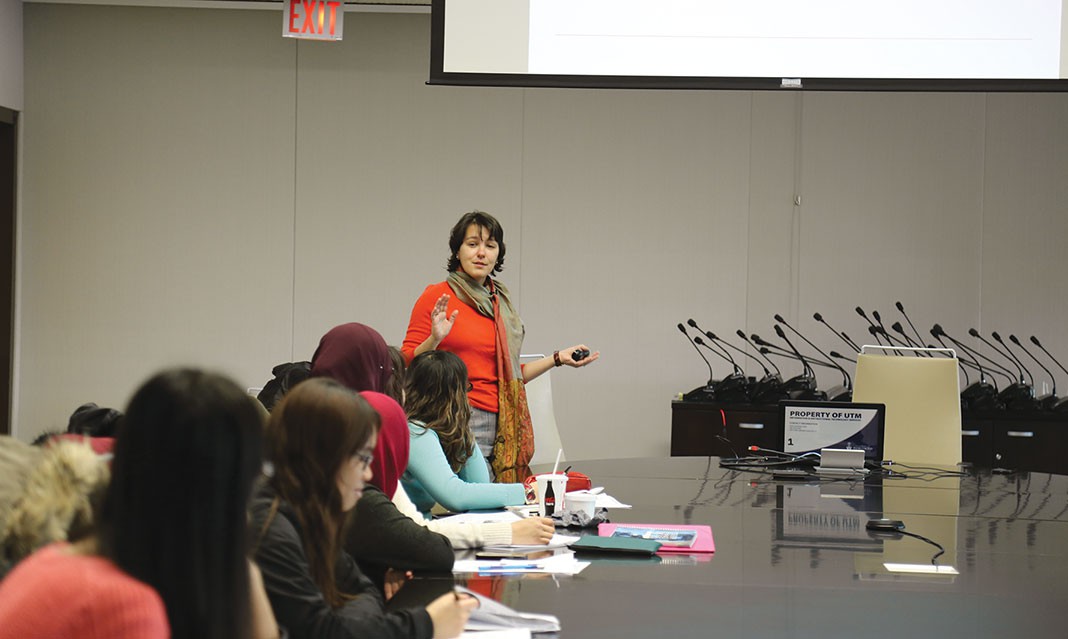If your heart is pounding and your palms are sweaty, odds are that you’re either on a first date or standing before a U.S. consulate officer applying for a visitor visa. But even if you think you have “game”, your chances of getting a thumbs-up are probably higher—at around 90 percent, according to the U.S. Consulate General in Toronto—with the officer behind the glass.
In fact, consular officer chief Scott Renner from the U.S. consulate general in Toronto, who, like many on his team, interviews approximately 100 applicants from over 50 different countries on a daily basis, says that last year alone 25,000 U.S. visa applications were processed from students studying in Canada. At institutions like U of T, a very high percentage of students intending to visit the U.S. are granted approval.
While many generally assume that the process of applying for a visitor visa is a daunting one, vice-consul Nina Murray provided UTM students with an informative presentation to demystify the process, which may only take a week to complete, especially now during off-peak seasons.
This comes as good news to UTM students like Bola Balogun, a first-year computer science student who is not a Canadian citizen and will require a visa in order to travel to visit relatives in the U.S. over the summer.
However, not all visa classifications are the same and they vary depending on the intent of travel to the U.S., which must be clearly stated in the application process. Visa categories are denoted with different codes, or, as Murray describes it, “an alphabet soup of visa classifications”.
Those participating in an internship, summer work, or exchange program must apply for a J1 visa, while those who plan on studying in the U.S. will require an F1 visa. With an F1, students must obtain a signed I-20 certificate of eligibility from the institution they plan to attend and register in the Student and Exchange Visitor Information System, similar to Canadian citizens who wish to study in the U.S. but do not require a visa.
However, in her experience of adjudicating visas, Murray says, “We see a majority of students just apply for their B1/B2 visas,” which permit travel intended for attending job interviews, workshops, visiting relatives, sightseeing, and shopping.
After determining the type of visa that corresponds with their intended purpose of travel, applicants must then complete the DS-160—an online application form—pay the application fee, and schedule an interview with a consular officer.
Cue the sweaty palms.
But the brief, one-minute interview shouldn’t be that nerve-wracking, especially when you have close ties to family in Canada, to a Canadian school, and a long-term plan for living in Canada, Renner assures. “These are all factors that will make your case for approval of a visa much stronger,” he says.
Why? Well, in most cases, regardless of the type of non-immigrant visa a student applies for, under 214(b) of the Immigration and National Act, all applicants must sufficiently demonstrate to the consular officer that they plan on returning back to Canada and keeping true to their non-immigrant or “visitor” status.
Renner states that “all applicants for non-immigrant visas are viewed as intending immigrants until they can convince the consular officer otherwise”.
But above all else, Renner advises students to tell the truth about their intentions to travel.

“Students travelling during the holiday season is something we expect to find, but if you’re unexpectedly leaving in the middle of your semester, be prepared to explain and provide evidence on what your true intentions are,” he says.
For students who have graduated and are offered temporary employment in specialty fields in the U.S., the process is slightly different. The applicants must complete an H1B visa, which involves the employer petitioning for entry of the employee. Although the H1B is a non-immigrant visa, it can also be recognized as dual intent as holders can later apply for permanent residency.
This plan of action is something that first-year management student Abhi Kalita considers in his future, as he feels the labour market in Canada for graduates is looking grim.
“I think it should be better to find a job in Canada, considering the way the government supports you here, but I think long-term job prospects in the U.S. are more promising and financially rewarding,” he says.
Whatever your reasons may be, getting the information you need to initiate the visa application process is essential.



